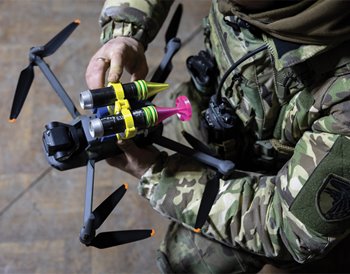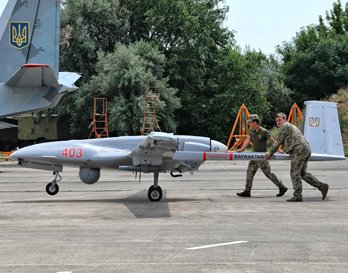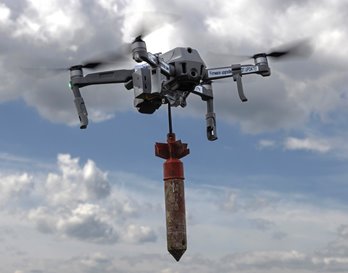Begun, the Drone Wars Have
Begun, the Drone Wars Have
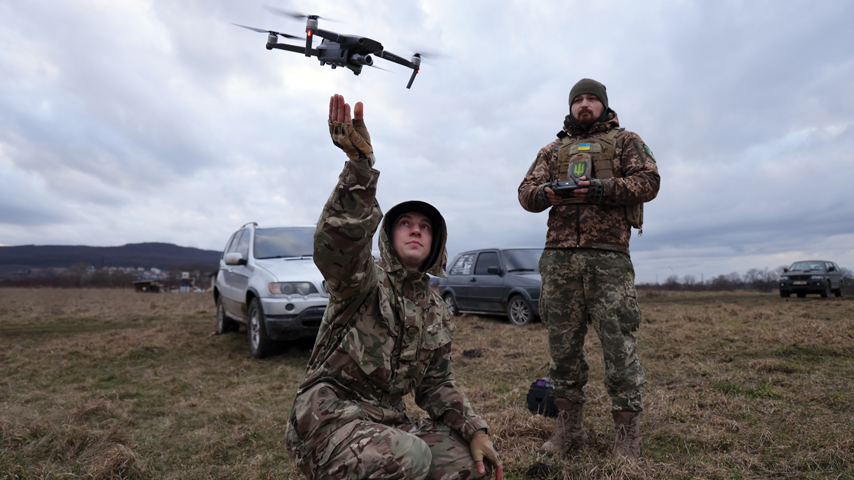

The conflict in Ukraine has showcased the growing capability of uncrewed aerial systems. Military analysts now look to apply the lessons of this war to future battles—large and small.
The war between Russia and Ukraine is groundbreaking in multiple ways. It is the first to be streamed on social media, with Twitter being an important source of information and disinformation. It is the first where crowdsourcing, the collection of funds online via small (often anonymous) contributions, has been used to purchase frontline weapons. It has also been a testbed for new, distributed uses of uncrewed aerial systems—UASs, or drones—for enemy surveillance and bombardment.
These three threads came together in April 2022, when a video from a modified DJI Phantom 3 hobbyist drone was posted to Twitter. The drone hovered over a small detachment of Russian troops outside a destroyed building. When the troops entered an SUV to drive away, the drone released a grenade that fell for a few seconds, sailed through the open sunroof of the vehicle, and detonated.
Uncrewed systems have been used by the American military for decades, but those have been relatively large and expensive vehicles, often operated by pilots hundreds or thousands of miles away. The war in Ukraine has taken drone warfare to new levels of sophistication and immediacy, with a small military power more than holding its own against a major and supposedly far superior opponent, and with troops in the theater of operation using the UASs to spot for artillery or engage nearby enemy formations directly.
“The Ukraine conflict illustrates that the era of drone warfare is just beginning,” said Zachary Kallenborn, a national security consultant and adjunct fellow with the Strategic Technology Program at the Center for Strategic and International Studies, a policy research organization based in Washington, D.C.
Become a Member of ASME's Engineering Community
Military strategists have long forecasted the advent of robots in combat. (The Q-UGV quadruped robot operated by the U.S. military was featured in the article “War Dogs” in the August/September 2022 issue of Mechanical Engineering.) But the speed at which soldiers from both Ukraine and Russia developed UAS tactics and countermeasures has been astonishing.
“We’re watching the acceleration of a transition of what I describe as the robotization of warfare in all of its domains,” said Peter Wilson, a senior defense policy analyst at RAND, the policy research institute. “This war will accelerate and enhance this process.”
During the first phase of the war, when the role of traditional airpower as represented by piloted fighter, bomber, and ground attack aircraft, was largely blunted by sophisticated ground defenses, unmanned aerial vehicles picked up the slack. Drones are cheap, supremely portable, and generally don’t require full-size airstrips or the other infrastructure needed to support manned flight operations. They have been perfect weapons in a fight between a resourceful middle-income nation and its giant, nuclear-armed neighbor. Over a year into a conflict that shows no signs of ending anytime soon, however, the ultimate impact of drone warfare in Ukraine, as well as its implications for future conflicts around the world, remain unclear.
“We’re in a situation analogous to when the mainframe computer was challenged by Bill Gates and the PC,” Wilson said. “Is that what we’re watching? Given the velocity of technological change, this decade may well be the turning point.”
Pilotless aircraft have been used in warfare in one form or another since the beginning of flight, first in the form of balloons then as powered aircraft within a decade of the Wright Brothers’ success at Kitty Hawk. Early attempts at uncrewed systems had no remote control—instead, the aircraft were launched and flew or drifted toward the target. Radio-controlled planes, essentially scaled up hobbyist aircraft, began to be developed after World War II for use in reconnaissance or as decoys.
After the end of the Cold War, the United States started flying long-range, long-duration UASs such as the Predator or Global Hawk designed to support and in many cases to replace crewed aircraft, which had gotten so sophisticated and expensive that militaries were hesitant to risk losing them.
“Mobile air defenses have become sufficiently hard to get rid of on the battlefield,” Wilson said, “so it has made the operation of manned fighting vehicles, aerial combat vehicles like attack helicopters, jets, armed with short range bombs, rockets, whatever, far too dangerous.”
Large, capable systems such as the Global Hawk—a reconnaissance drone with a turbofan engine and an eight-figure price tag—had more in common with conventional military aircraft than with the lightweight, small, and increasingly inexpensive drones that have flooded the recreational and commercial markets in the last 10 years.
Not long before the war in Ukraine, a short conflict between Armenia and Azerbaijan hinted at what would come, Wilson said. Azerbaijan mixed large Bayraktar TB2 UAVs, which carry missiles and can stay aloft all day, with smaller loitering munitions, also known as “kamikaze” or suicide drones, which would circle until they found a target and then dive toward it. Reportedly, the Azerbaijani forces also modified Soviet-era biplanes to fly via remote control in order to draw out Armenian defenses. But the use of UASs to find, track, and attack targets, either directly or by feeding coordinates to artillery squads, drew the attention of keen observers.
“The Azerbaijanis set a new precedent by basically winning the war using drones and surveillance and long-range strike weapons,” Wilson said, “and not using their air force because of the threat of the Armenian air defenses, very much similar to the fighting that we’ve seen in Ukraine.”
While the 44-day war between Armenia and Azerbaijan in 2020 was over before most people could focus on it, the unexpected success of Ukrainian fighters to resist Russian tanks rolling into their nation has drawn the attention of professional military analysts and armchair generals alike. And it was clear from the beginning that drones played a much larger role in operations than in any previous conflict.
More on Drone Warfare: High-Powered Microwaves Knock Drones from the Sky
Initially, the thought was that the Russian military, with access to a larger domestic defense industrial base, would deploy more sophisticated systems that could multiply the effect of its troops on the ground. According to Keir Giles, senior consulting fellow of the Russia and Eurasia program at Chatham House, a UK-based international affairs think tank, as the war unfolded, it became clear that wasn’t the case. Giles wrote in a commentary published on CNN.com, “Ukraine entered the drone war fully prepared—after a long process of upgrading capabilities and adapting tactics based on the lessons of its eight-year struggle against Russian regular and proxy forces in the east of the country.”
Indeed, it was the Ukrainian troops who were able to take advantage of a wide variety of uncrewed platforms, much as the Azerbaijanis did two years earlier, using everything from Bayraktars to hobbyist drones. The Bayraktar became famous enough as an icon of Ukrainian defiance in the early months of the war to inspire a popular song and video. But store-bought quad- and octocopters such as the Chinese Autel EVO II and American Skydio X2 have also played important roles.
“For applications like artillery spotting, you don’t need a fancy military system to do that,” Kallenborn said. “You need a camera and that’s about it.”
Forward observers have long been used to help artillery batteries home in on their targets whenever the range of the guns outpaced the gunners’ line of sight. Drones significantly improve the process since they can fly directly over troops, vehicles, and buildings. Not only can they uncover the locations of camouflaged equipment and dug in soldiers, but they can immediately relay the location of artillery shell impacts relative to the location of the targets, enabling batteries to adjust their sites and fire again quickly.
The feedback loop can radically reduce the number of shots it takes to hit a target and shrink the diameter of uncertainty—known as circular error probable. Rather than expend expensive precision-guided missiles, drone-adjusted fire enables troops to use cheap artillery shells to accomplish the same effect. There are some accounts of drone-adjusted fire hitting tanks and other vehicles on the move.
To counteract these capabilities, something of an arms race has arisen, with Russian electronic warfare equipment jamming signals between Ukrainian drones and their operators. For example, Ukrainian forces have found the Chinese-made DJI Mavic drone series, designed and built for civilian use, to be a versatile platform for everything from low-level reconnaissance to dropping small grenades. But according to a May 2023 report issued by Royal United Services Institute for Defense and Security Studies, a British military think tank, “The Russian military is also continuing to make extensive use of navigational interference in the battle area as a form of electronic protection. This is contributing to a Ukrainian loss rate in UAVs of approximately 10,000 per month.”
Editor's Choice: An Avian Drone Flaps Its Way into the Sky
The increasing Russian abilities to jam and spoof DJI drones are sharply limiting their effectiveness to the point that Ukrainian drone operators are scrambling to find alternatives or develop countermeasures. Volunteers who helped convert donated commercial drones by adding mechanisms to drop grenades are now hardening the electronic system more effectively against jamming or GPS manipulation.
Even with UAS losses on the scale noted in the report, it is preferable to replace thousands of drones than to lose the wildly expensive airframes designed to protect priceless human pilots. And the expendability built into UASs can open new tactics. One is the massed drone attack, which overwhelms targeted locations with cheap craft armed with explosives. Those attacks have, in turn, led to speculation about something far more ominous: The possibility of fully autonomous “drone swarms” that act as a single, integrated system.
It’s a prospect that has been on the horizon for some time. Advances in robotics, artificial intelligence, and drone technology have made possible—even inevitable—the creation of autonomous systems that could identify, select, and kill, all without any human control or involvement.
“We’ve only seen in the last couple years the mass use of drones on the battlefield,” Kallenborn said. “And the reality is the technology is developing incredibly quickly, even though some of those innovations we haven’t seen yet in Ukraine, things like the use of artificial intelligence to make decisions about what the weapon system does and who it targets. We’ve seen mass use of drones on both sides, but we haven’t seen either side employ true drone swarms. Although I know Russia is developing that capability and has been quite interested in it.”
Although some technologists have raised the alarm over prospects of out-of-control flying killer robots and have called for a complete moratorium on autonomous lethal weapons or at least well-defined limitations, other experts are more sanguine. Those analysts are confident that rather than completely unrestrained Terminator-type killer machines, autonomous drones will be used in a more limited way to augment military operations, aiding lethal decision-making while leaving the final say to a human, or operating in “autonomous collaborative platforms” in conjunction with piloted combat aircraft as detailed in a recent study from the Mitchell Institute for Aerospace Studies, an aviation-focused think tank in Arlington, Va.
The war in Ukraine has made it clear that drones in whatever incarnation, whether human-controlled or autonomous, have evolved from mere curiosities and peripheral players to become a major part of modern warfare. More countries around the globe will be increasingly adopting the technology in different ways and using different strategies, building on the extensive experience and examples provided by the Ukraine conflict, including the development of countermeasures and defenses and direct drone-on-drone combat.
Next-Gen Aviation: Five Ways Drone Technology is Improving
Some experts, such as Caitlin Lee, senior fellow for the Mitchell Institute’s Center for UAV and Autonomy Studies, argue that the U.S. Air Force needs to rethink its plans to retire its venerable Global Hawk and Reaper drones. Instead, the U.S. should integrate their uses with newly developed UASs and “double down on drone innovation by protecting and improving on its current inventory, while also committing to the fielding of a new generation of drone technologies.”
And much like the way crewed aircraft evolved from slow-moving, single-seater biplanes of World War I to the long-range strategic bombers of World War II and the Cold War, advances in capability and tactics will open new frontiers in drone warfare.
“I think you’ve got to look at two levels. The implications for the battlefield, which I’ll define as the fighting between armies within a few hundred kilometers of each other, that’s one dimension of this which we’ve seen. And the other one is the prospect that countries will be subject to robotic bombardment strategically,” said RAND’s Wilson. “It raises some interesting questions. Should the United States start to think about how does it protect its strategic assets against strategic attack other than through cyberspace? We rely on nuclear deterrence, but it’s not clear that nuclear forces can deter or will deter the use of conventional forces in this fashion.”
Although the war in Ukraine has fixed the attention of military experts and planners for the past 18 months, its impact has yet to be seen in the structure and doctrine of the U.S. armed forces.
Wilson believes changes are coming.
“It raises questions for the U.S. Navy about the viability of large, expensive fighting vehicles such as aircraft carriers.
Is the character of naval war going to undergo a change? Similar arguments are being made about the battle tank, the premier vehicle of the Army, or the Air Force and manned combat aviation. Are we watching some really fundamental shifts?” Wilson asked.
“This particular war, given its duration, scale, and consequence globally, is going to be one of those regional wars that will act as an accelerant,” he continued. “War always acts as an accelerant to all kinds of innovation. That’s happening as we speak.”
Mark Wolverton is a science and technology writer in Narbeth, Pa.
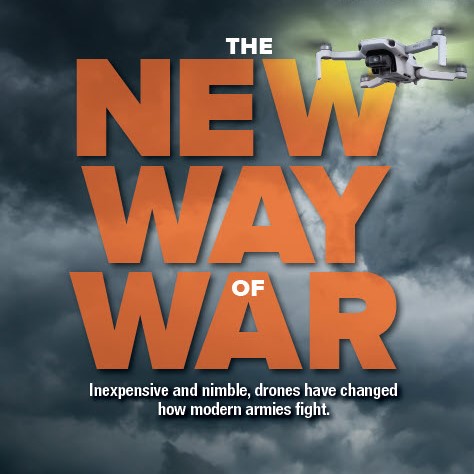
These three threads came together in April 2022, when a video from a modified DJI Phantom 3 hobbyist drone was posted to Twitter. The drone hovered over a small detachment of Russian troops outside a destroyed building. When the troops entered an SUV to drive away, the drone released a grenade that fell for a few seconds, sailed through the open sunroof of the vehicle, and detonated.
Uncrewed systems have been used by the American military for decades, but those have been relatively large and expensive vehicles, often operated by pilots hundreds or thousands of miles away. The war in Ukraine has taken drone warfare to new levels of sophistication and immediacy, with a small military power more than holding its own against a major and supposedly far superior opponent, and with troops in the theater of operation using the UASs to spot for artillery or engage nearby enemy formations directly.
“The Ukraine conflict illustrates that the era of drone warfare is just beginning,” said Zachary Kallenborn, a national security consultant and adjunct fellow with the Strategic Technology Program at the Center for Strategic and International Studies, a policy research organization based in Washington, D.C.
Become a Member of ASME's Engineering Community
Military strategists have long forecasted the advent of robots in combat. (The Q-UGV quadruped robot operated by the U.S. military was featured in the article “War Dogs” in the August/September 2022 issue of Mechanical Engineering.) But the speed at which soldiers from both Ukraine and Russia developed UAS tactics and countermeasures has been astonishing.
“We’re watching the acceleration of a transition of what I describe as the robotization of warfare in all of its domains,” said Peter Wilson, a senior defense policy analyst at RAND, the policy research institute. “This war will accelerate and enhance this process.”
During the first phase of the war, when the role of traditional airpower as represented by piloted fighter, bomber, and ground attack aircraft, was largely blunted by sophisticated ground defenses, unmanned aerial vehicles picked up the slack. Drones are cheap, supremely portable, and generally don’t require full-size airstrips or the other infrastructure needed to support manned flight operations. They have been perfect weapons in a fight between a resourceful middle-income nation and its giant, nuclear-armed neighbor. Over a year into a conflict that shows no signs of ending anytime soon, however, the ultimate impact of drone warfare in Ukraine, as well as its implications for future conflicts around the world, remain unclear.
“We’re in a situation analogous to when the mainframe computer was challenged by Bill Gates and the PC,” Wilson said. “Is that what we’re watching? Given the velocity of technological change, this decade may well be the turning point.”
Attack vector
Pilotless aircraft have been used in warfare in one form or another since the beginning of flight, first in the form of balloons then as powered aircraft within a decade of the Wright Brothers’ success at Kitty Hawk. Early attempts at uncrewed systems had no remote control—instead, the aircraft were launched and flew or drifted toward the target. Radio-controlled planes, essentially scaled up hobbyist aircraft, began to be developed after World War II for use in reconnaissance or as decoys.
After the end of the Cold War, the United States started flying long-range, long-duration UASs such as the Predator or Global Hawk designed to support and in many cases to replace crewed aircraft, which had gotten so sophisticated and expensive that militaries were hesitant to risk losing them.
“Mobile air defenses have become sufficiently hard to get rid of on the battlefield,” Wilson said, “so it has made the operation of manned fighting vehicles, aerial combat vehicles like attack helicopters, jets, armed with short range bombs, rockets, whatever, far too dangerous.”
Large, capable systems such as the Global Hawk—a reconnaissance drone with a turbofan engine and an eight-figure price tag—had more in common with conventional military aircraft than with the lightweight, small, and increasingly inexpensive drones that have flooded the recreational and commercial markets in the last 10 years.
Not long before the war in Ukraine, a short conflict between Armenia and Azerbaijan hinted at what would come, Wilson said. Azerbaijan mixed large Bayraktar TB2 UAVs, which carry missiles and can stay aloft all day, with smaller loitering munitions, also known as “kamikaze” or suicide drones, which would circle until they found a target and then dive toward it. Reportedly, the Azerbaijani forces also modified Soviet-era biplanes to fly via remote control in order to draw out Armenian defenses. But the use of UASs to find, track, and attack targets, either directly or by feeding coordinates to artillery squads, drew the attention of keen observers.
“The Azerbaijanis set a new precedent by basically winning the war using drones and surveillance and long-range strike weapons,” Wilson said, “and not using their air force because of the threat of the Armenian air defenses, very much similar to the fighting that we’ve seen in Ukraine.”
While the 44-day war between Armenia and Azerbaijan in 2020 was over before most people could focus on it, the unexpected success of Ukrainian fighters to resist Russian tanks rolling into their nation has drawn the attention of professional military analysts and armchair generals alike. And it was clear from the beginning that drones played a much larger role in operations than in any previous conflict.
More on Drone Warfare: High-Powered Microwaves Knock Drones from the Sky
Initially, the thought was that the Russian military, with access to a larger domestic defense industrial base, would deploy more sophisticated systems that could multiply the effect of its troops on the ground. According to Keir Giles, senior consulting fellow of the Russia and Eurasia program at Chatham House, a UK-based international affairs think tank, as the war unfolded, it became clear that wasn’t the case. Giles wrote in a commentary published on CNN.com, “Ukraine entered the drone war fully prepared—after a long process of upgrading capabilities and adapting tactics based on the lessons of its eight-year struggle against Russian regular and proxy forces in the east of the country.”
Indeed, it was the Ukrainian troops who were able to take advantage of a wide variety of uncrewed platforms, much as the Azerbaijanis did two years earlier, using everything from Bayraktars to hobbyist drones. The Bayraktar became famous enough as an icon of Ukrainian defiance in the early months of the war to inspire a popular song and video. But store-bought quad- and octocopters such as the Chinese Autel EVO II and American Skydio X2 have also played important roles.
“For applications like artillery spotting, you don’t need a fancy military system to do that,” Kallenborn said. “You need a camera and that’s about it.”
Forward observers have long been used to help artillery batteries home in on their targets whenever the range of the guns outpaced the gunners’ line of sight. Drones significantly improve the process since they can fly directly over troops, vehicles, and buildings. Not only can they uncover the locations of camouflaged equipment and dug in soldiers, but they can immediately relay the location of artillery shell impacts relative to the location of the targets, enabling batteries to adjust their sites and fire again quickly.
The feedback loop can radically reduce the number of shots it takes to hit a target and shrink the diameter of uncertainty—known as circular error probable. Rather than expend expensive precision-guided missiles, drone-adjusted fire enables troops to use cheap artillery shells to accomplish the same effect. There are some accounts of drone-adjusted fire hitting tanks and other vehicles on the move.
To counteract these capabilities, something of an arms race has arisen, with Russian electronic warfare equipment jamming signals between Ukrainian drones and their operators. For example, Ukrainian forces have found the Chinese-made DJI Mavic drone series, designed and built for civilian use, to be a versatile platform for everything from low-level reconnaissance to dropping small grenades. But according to a May 2023 report issued by Royal United Services Institute for Defense and Security Studies, a British military think tank, “The Russian military is also continuing to make extensive use of navigational interference in the battle area as a form of electronic protection. This is contributing to a Ukrainian loss rate in UAVs of approximately 10,000 per month.”
Editor's Choice: An Avian Drone Flaps Its Way into the Sky
The increasing Russian abilities to jam and spoof DJI drones are sharply limiting their effectiveness to the point that Ukrainian drone operators are scrambling to find alternatives or develop countermeasures. Volunteers who helped convert donated commercial drones by adding mechanisms to drop grenades are now hardening the electronic system more effectively against jamming or GPS manipulation.
Battle horizon
Even with UAS losses on the scale noted in the report, it is preferable to replace thousands of drones than to lose the wildly expensive airframes designed to protect priceless human pilots. And the expendability built into UASs can open new tactics. One is the massed drone attack, which overwhelms targeted locations with cheap craft armed with explosives. Those attacks have, in turn, led to speculation about something far more ominous: The possibility of fully autonomous “drone swarms” that act as a single, integrated system.
It’s a prospect that has been on the horizon for some time. Advances in robotics, artificial intelligence, and drone technology have made possible—even inevitable—the creation of autonomous systems that could identify, select, and kill, all without any human control or involvement.
“We’ve only seen in the last couple years the mass use of drones on the battlefield,” Kallenborn said. “And the reality is the technology is developing incredibly quickly, even though some of those innovations we haven’t seen yet in Ukraine, things like the use of artificial intelligence to make decisions about what the weapon system does and who it targets. We’ve seen mass use of drones on both sides, but we haven’t seen either side employ true drone swarms. Although I know Russia is developing that capability and has been quite interested in it.”
Although some technologists have raised the alarm over prospects of out-of-control flying killer robots and have called for a complete moratorium on autonomous lethal weapons or at least well-defined limitations, other experts are more sanguine. Those analysts are confident that rather than completely unrestrained Terminator-type killer machines, autonomous drones will be used in a more limited way to augment military operations, aiding lethal decision-making while leaving the final say to a human, or operating in “autonomous collaborative platforms” in conjunction with piloted combat aircraft as detailed in a recent study from the Mitchell Institute for Aerospace Studies, an aviation-focused think tank in Arlington, Va.
The war in Ukraine has made it clear that drones in whatever incarnation, whether human-controlled or autonomous, have evolved from mere curiosities and peripheral players to become a major part of modern warfare. More countries around the globe will be increasingly adopting the technology in different ways and using different strategies, building on the extensive experience and examples provided by the Ukraine conflict, including the development of countermeasures and defenses and direct drone-on-drone combat.
Next-Gen Aviation: Five Ways Drone Technology is Improving
Some experts, such as Caitlin Lee, senior fellow for the Mitchell Institute’s Center for UAV and Autonomy Studies, argue that the U.S. Air Force needs to rethink its plans to retire its venerable Global Hawk and Reaper drones. Instead, the U.S. should integrate their uses with newly developed UASs and “double down on drone innovation by protecting and improving on its current inventory, while also committing to the fielding of a new generation of drone technologies.”
And much like the way crewed aircraft evolved from slow-moving, single-seater biplanes of World War I to the long-range strategic bombers of World War II and the Cold War, advances in capability and tactics will open new frontiers in drone warfare.
“I think you’ve got to look at two levels. The implications for the battlefield, which I’ll define as the fighting between armies within a few hundred kilometers of each other, that’s one dimension of this which we’ve seen. And the other one is the prospect that countries will be subject to robotic bombardment strategically,” said RAND’s Wilson. “It raises some interesting questions. Should the United States start to think about how does it protect its strategic assets against strategic attack other than through cyberspace? We rely on nuclear deterrence, but it’s not clear that nuclear forces can deter or will deter the use of conventional forces in this fashion.”
Although the war in Ukraine has fixed the attention of military experts and planners for the past 18 months, its impact has yet to be seen in the structure and doctrine of the U.S. armed forces.
Wilson believes changes are coming.
“It raises questions for the U.S. Navy about the viability of large, expensive fighting vehicles such as aircraft carriers.
Is the character of naval war going to undergo a change? Similar arguments are being made about the battle tank, the premier vehicle of the Army, or the Air Force and manned combat aviation. Are we watching some really fundamental shifts?” Wilson asked.
“This particular war, given its duration, scale, and consequence globally, is going to be one of those regional wars that will act as an accelerant,” he continued. “War always acts as an accelerant to all kinds of innovation. That’s happening as we speak.”
Mark Wolverton is a science and technology writer in Narbeth, Pa.

